Global microelectronic shortages trickle down to military satellite programs
Thursday, 26 August 2021 19:45
Defense Department satellite programs are feeling the effects of the widespread microchip shortage that has stymied carmakers and consumer electronic manufacturers.
ESA pursuing European space summit to discuss new flagship space programs
Thursday, 26 August 2021 19:40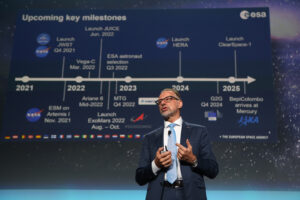
The head of the European Space Agency says plans are moving forward to host a European space summit early next year to discuss proposals for new major space initiatives.
SLS cubesats arrive for Artemis 1 launch
Thursday, 26 August 2021 18:34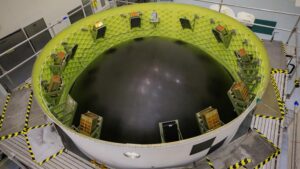
While most of the cubesats manifested to launch as secondary payloads on the first Space Launch System mission have arrived, at least one of them will miss its flight.
Engineers test liquid acquisition device aboard Blue Origin's New Shepard rocket
Thursday, 26 August 2021 18:28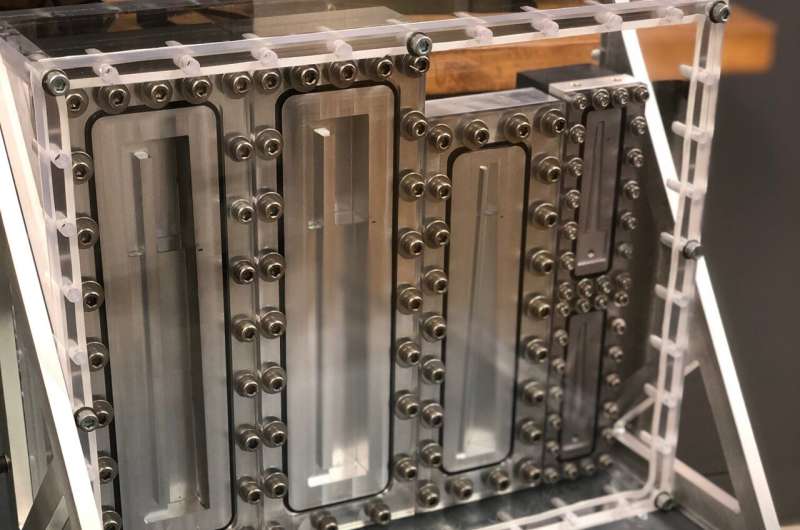
A Southwest Research Institute (SwRI) experiment was performed aboard Blue Origin's New Shepard suborbital rocket today, which launched from Van Horn, Texas. Five variations of the tapered liquid acquisition device (LAD), which is designed to safely deliver liquid propellant to a rocket engine from fuel tanks, were aboard the rocket to evaluate their performance in microgravity.
White House to revise charter and membership of space council advisory group
Thursday, 26 August 2021 18:17
The Biden administration plans to revise both the charter and the membership of the National Space Council’s advisory group to better reflect its priorities.
Blue Origin launches artwork, moon-landing test into space
Thursday, 26 August 2021 16:44
Blue Origin launched artwork painted on a capsule and a moon-landing navigation experiment into space Thursday, a month after sending founder Jeff Bezos on the company's first passenger flight.
No one was aboard for Thursday's 10-minute flight, which included other experiments from NASA and others.
The paintings by Ghana artist Amoako Boafo were on three parachute panels on the outside of the capsule at the very top. Boafo painted a self-portrait as well as portraits of his mother and a friend's mother, explaining "a mother's love comes from a place that is out of this world," said Blue Origin launch commentator Kiah Erlich, a company official.
Chinese commercial sector investment lagging in 2021
Thursday, 26 August 2021 16:05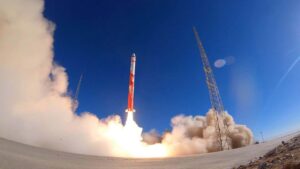
China’s commercial space sector has been expanding rapidly ever since the central government opened space to private capital, but activity appears to be slowing.
All future Starlink satellites will have laser crosslinks
Thursday, 26 August 2021 15:58
SpaceX is adding laser terminals on all future Starlink satellites and is the reason behind a break in launches for the broadband megaconstellation, president and chief operating officer Gwynne Shotwell said.
Fire ravages Esrange Space Centre in northern Sweden
Thursday, 26 August 2021 15:23A large fire tore through a scientific space research centre in northern Sweden on Thursday, destroying part of the rocket launch pad, officials said.
The fire broke out early Thursday "during a scheduled static firing test of a solid rocket motor" and was under control by late afternoon when "post-extinguishing work" was being conducted, Esrange Space Centre said in a statement.
Located in the town of Kiruna, the centre is a base for scientific research with high-altitude balloons, studies on the aurora borealis phenomenon (also known as the Northern Lights), sounding rocket launches and satellite tracking, among other things.
No injuries were reported, though some staff were taken to hospital for a check-up.
The fire damaged "part of the sounding rocket launching infrastructure", Esrange Space Centre said.
"The full extent of damages and consequences for launching operations cannot yet be assessed," it said.
Explore further
© 2021 AFP
Space: The wooden frontier
Thursday, 26 August 2021 15:16
Humans have relied on forests and trees—for shelter, food, and fuel—from the earliest times. As technology has advanced, timber has been utilized for buildings, ships, and railroads. And now we may be on the verge of taking wood into space.
Why wood? Building in space with futuristic, 'space-age' materials might seem to be the obvious choice: lumber's fragility and combustibility might seem counter-intuitive by comparison.
Therein lies the rationale for wood: as a natural, economical, carbon-based material, its production is considerably more sustainable than advanced alternatives, and its disposal—especially when dropped from orbit into the upper atmosphere—is complete and without harmful byproducts.
Moreover, earlier investigations—in earth-bound labs—have demonstrated wood's surprising ability to withstand a wide range of temperatures, from -150 to 150 degrees Celsius.
Blue Origin flies payloads on latest New Shepard flight
Thursday, 26 August 2021 14:53
Blue Origin launched a New Shepard suborbital vehicle Aug. 25 on a mission carrying research and educational payloads as the company prepares for its next crewed flight.
Mynaric debuts space laser terminal with sights on U.S. expansion
Thursday, 26 August 2021 13:30
German antenna maker Mynaric unveiled a new optical satellite terminal Aug. 25 amid its push into the U.S laser communications market.
Experiment to grow miniature human tissue on the International Space Station
Thursday, 26 August 2021 13:01
The process for the joint 3D Organoids in Space project originated from the University of Zurich (UZH) researchers Oliver Ullrich and Cora Thiel. Together with Airbus, the two pioneers in research on how gravity affects and regulates human cells have developed the process to project maturity. The Airbus Innovations team led by project manager Julian Raatschen has developed the hardware and is providing access to the International Space Station (ISS). It took the project partners only three years from idea to the first production test in space. During this time, they completed various test phases and overcame highly competitive internal selection processes.
Geospatial intelligence giving supply chain clarity in uncertain times
Thursday, 26 August 2021 13:00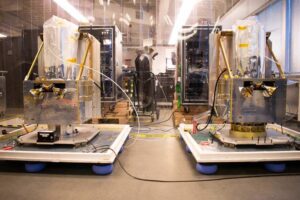
From hiking the price of cars to impacting the readiness of militaries, the havoc that COVID-19 wreaks across supply chains is far-ranging and sometimes surprising.
Webb completes testing and prepares for trip to Europe's Spaceport
Thursday, 26 August 2021 13:00
The NASA/ESA/CSA James Webb Space Telescope has successfully completed its final tests and is being prepared for shipment to its launch site at Europe’s Spaceport in French Guiana.

